The Impact of Welding Parameters on the Welding Strength of High Borosilicate Glass and Aluminum Alloy
Abstract
:1. Introduction
2. Experimental Materials and Methods
2.1. Experimental Materials
2.2. Experimental Equipment
- Wavelength: 1064 nm
- Pulse width: 0.1–20 ms
- Maximum frequency: 500 Hz
- Maximum power: 300 W
- Spot diameter: 0.2–20 mm
- Cooling system: Thermostatic closed-loop water cooling system
- Worktable travel range: 500 mm × 500 mm
2.3. Experimental Method
- Laser Power
- Pulse Width
- Frequency
- Defocus Amount
3. Experimental Results
3.1. Pre-Welding Surface Preparation
3.2. Impact of Defocus Amount on Welding of High Borosilicate Glass and Aluminum Alloy
3.3. Influence of Power on Welding Strength of Glass and Aluminum Alloy
3.4. Impact of Frequency on Welding Strength of Glass and Aluminum Alloy
3.5. Influence of Pulse Width on the Welding Strength of Glass and Aluminum Alloy
4. Discussion
5. Conclusions
- (1)
- With the continuous increase in defocusing amount, the shear force test results first increase and then decrease. The welding effect is optimal when the defocusing amount is 0 mm;
- (2)
- As the power increases, the fracture becomes noticeably wider, and the amount of spatter increases significantly. It can also be observed that with the increase in power, the adhesion on the aluminum alloy side gradually increases, while the adhesion on the glass side gradually decreases. The shear force increases with laser power initially but decreases afterward;
- (3)
- As the frequency increases, the morphology of the adhesive on the fracture of the aluminum alloy side gradually changes from large blocks to finer fragments. The increase in frequency causes the glass to be subjected to more energy impacts within the same volume, and excessively high frequency leads to significant heat accumulation. These two factors together result in an increase in the internal stress and number of cracks within the glass;
- (4)
- Increasing the pulse width can significantly enhance the energy during welding, and a higher pulse width allows for longer welding times, which helps to extend the duration of material flow between the molten aluminum alloy and the softened glass. However, when the pulse width is too large, the prolonged duration of energy input causes the aluminum alloy to melt more thoroughly and blend more completely with the glass. However, due to the excessive heat received by the glass and its low thermal expansion coefficient, excessive heat accumulation can cause damage and cracking of the glass.
Author Contributions
Funding
Data Availability Statement
Acknowledgments
Conflicts of Interest
References
- Buček, A.; Brablec, A.; Kováčik, D.; Sťahel, P.; Černák, M. Glass bond adhesive strength improvement by DCSBD atmospheric-pressure plasma treatment. Int. J. Adhes. Adhes. 2017, 78, 1–3. [Google Scholar] [CrossRef]
- Szesz, E.M.; Lepienski, C.M. Anodic bonding of titanium alloy with bioactive glass. J. Non-Crystaline Solids 2017, 471, 19–27. [Google Scholar] [CrossRef]
- Tan, M.; Ling, X. Analysis of Parameters Affecting Residual Stress in Glass-to-Metal Vacuum Brazed Joints. Trans. China Weld. Inst. 2012, 33, 21–24. [Google Scholar]
- Jia, L.; Li, Z.; Li, H.; Wolfgang, T. Effect of Intermediate Layer on Bonding Properties of Kovar Alloy 4J29/Molybdenum Glass DM308 Laser Welded Joints. Trans. China Weld. Inst. 2018, 39, 5–9. [Google Scholar]
- Ying, H. Feasibility Analysis of the Float Process for High Borosilicate Glass Production. China Glass. 2008, 29, 12–16. [Google Scholar]
- Pan, S. Application and Development Prospects of Borosilicate Glass. Henan Build. Mater. 2009. [Google Scholar] [CrossRef]
- Deng, X.; Wang, K.; Shi, W. Constitutive Model and Numerical Simulation of the Quenching Process of ZL205A Aluminum Alloy. J. Heat Treat. 2021, 42, 125–136. [Google Scholar]
- Zaffaina, L.; Alain, R.; Bonollo, F.; Fan, Z. New challenges and directions for high pressure die-cast magnesium. Metall. Ital. 2009, 3, 25–29. [Google Scholar]
- Lu, G. Analysis of laser welding technology for automotive plastic component. Foreign Plast. 2013. [Google Scholar] [CrossRef]
- Karim, M.A.; Park, Y.D. A review on welding of dissimilar metals in car body manufacturing. J. Weld. Join. 2020, 38, 8–23. [Google Scholar] [CrossRef]
- Balestriere, M.; Schuhladen, K.; Seitz, K.H.; Boccaccini, A.; Cere, S.; Ballarre, J. Sol-gel coatings incorporating borosilicate bioactive glass enhance anti corrosive and surface performance of stainless steel implants. J. Electroanal. Chem. 2020. [Google Scholar] [CrossRef]
- Wang, H.Z. The Research on the Laser Coloring Mechanism of Stainless Steel and Its Practical Applications. Master’s Thesis, Shandong University, Jinan, China, 2022. [Google Scholar]
- Li, J.; Yang, Y.; Ren, Y.; Dong, J.; Yang, K. Effect of cold deformation on corrosion fatigue behavior of nickel-free high nitrogen austenitic stainless steel for coronary stent application. J. Mater. Sci. Technol. 2018, 34, 660–665. [Google Scholar] [CrossRef]
- Lei, D.; Wang, Z.; Li, J. The calculation and analysis of glass-to-metal sealing stress in solar absorber tube. Renew. Energy 2010, 35, 405–411. [Google Scholar] [CrossRef]
- Ciuca, O.P.; Carter, R.M.; Prangnell, P.B.; Hand, D.P. Characterization of weld zone reaction dissimilar glass-to-aluminum pulsed picosecond laser welds. Materials 2016, 120, 53–62. [Google Scholar]
- Lin, H.K.; Hong, S.Z.; Chung, B.F.; Lin, R.C. Characterization of local laser bonding quartz to anodic aluminum oxide in light emission device. J. Opt. Quantum Electron. 2017, 49, 1–8. [Google Scholar] [CrossRef]
- Qiu, Z.L. The Research on Laser Welding Performance and Mechanism of Micro-Arc Oxidized Aluminum Alloy and High-Aluminum Ultra-Thin Glass. Master’s Thesis, Southwest Forestry University, Kunming, China, 2018. [Google Scholar]
- Li, C.Y.; Zhang, M.; Chen, C.J.; Wang, X.N.; Chen, W.G. Effects and mechanisms of laser weld spacing and welding passes on the laser sealing performance of glass and aluminum alloy. Chin. J. Lasers 2016, 43, 114–121. [Google Scholar]
- Lu, Y.J.; Zhang, Z.L.; Liu, Y.J.; Yu, C.; Zhang, X.; Liu, X.C. Improving mechanical properties and corrosion behavior of biomedical Ti-3Zr-2Sn-3Mo-25Nb alloy through laser surface remelting. Surf. Coat. Technol. 2024, 490. [Google Scholar] [CrossRef]
- Chen, R.; Wang, H.; Li, J.; He, B.; Shao, W.; Zhang, S. Effect of laser remelting and heat treatment on microstructure and wear resistance of 2A97 Al-Li alloy. Surf. Interfaces 2022, 33. [Google Scholar] [CrossRef]
- Lei, D.; Wang, Z.; Li, J.; Li, J.; Wang, Z. Experimental study of glass to metal seals for parabolic trough receivers. Renew. Energy 2012, 48, 85–91. [Google Scholar] [CrossRef]
- Li, P.; Xu, X.; Tan, W.; Liu, H.; Wang, X. Improvement of Laser Transmission Welding of Glass with Titanium Alloy by Laser Surface Treatment. Materials 2018, 11. [Google Scholar] [CrossRef]
- Kuo, C.H.; Cheng, P.Y.; Chou, C.P. Matched glass-to-Kovar seals in N2 and Ar atmospheres. Int. J. Miner. Metall. Mater. 2013, 20, 874–882. [Google Scholar] [CrossRef]
- Min, Z.; Yufei, C.; Changjun, C.; Zhaoling, Q. A new sealing technology for ultra-thin glass to aluminum alloy by laser transmission welding method. Int. J. Adv. Manuf. Technol. 2021, 115, 2017–2035. [Google Scholar] [CrossRef]
- Sahoo, S.K.; Bishoyi, B.; Mohanty, U.K.; Sahoo, S.K.; Sahu, J.; Bathe, R.N. Effect of laser beam welding on microstructure and mechanical properties of commercially pure titanium. Trans. Indian Inst. Met. 2017, 70, 1817–1825. [Google Scholar] [CrossRef]
- Ahn, J.; Chen, L.; Davies, C.M.; Dear, J.P. Parametric optimisation and microstructural analysis on high power Yb-fiber laser welding of Ti–6Al–4V. Opt. Lasers Eng. 2016, 86, 156–171. [Google Scholar] [CrossRef]
- Xu, Z.Z.; Dong, Z.Q.; Yu, Z.H.; Wang, W.K.; Zhang, J.X. Relationships between microhardness, microstructure, and grain orientation in laser-welded joints with different welding speeds for Ti6Al4V titanium alloy. Trans. Nonferrous Met. Soc. China 2020, 30, 1277–1289. [Google Scholar] [CrossRef]
- ASTM F734-17Standard Test Method for Shear Strength of Fusion Bonded Polycarbonate Aerospace Glazing Material, ASTM International: West Conshohocken, PA, USA, 2017. [CrossRef]
- Susnik, J.; Grum, J.; Sturm, R. Effect of Pulse Laser Energy Density on Tic Cladding of Aluminium Substrate. Teh. Vjesn.-Tech. Gaz. 2015, 22, 1553–1560. [Google Scholar]
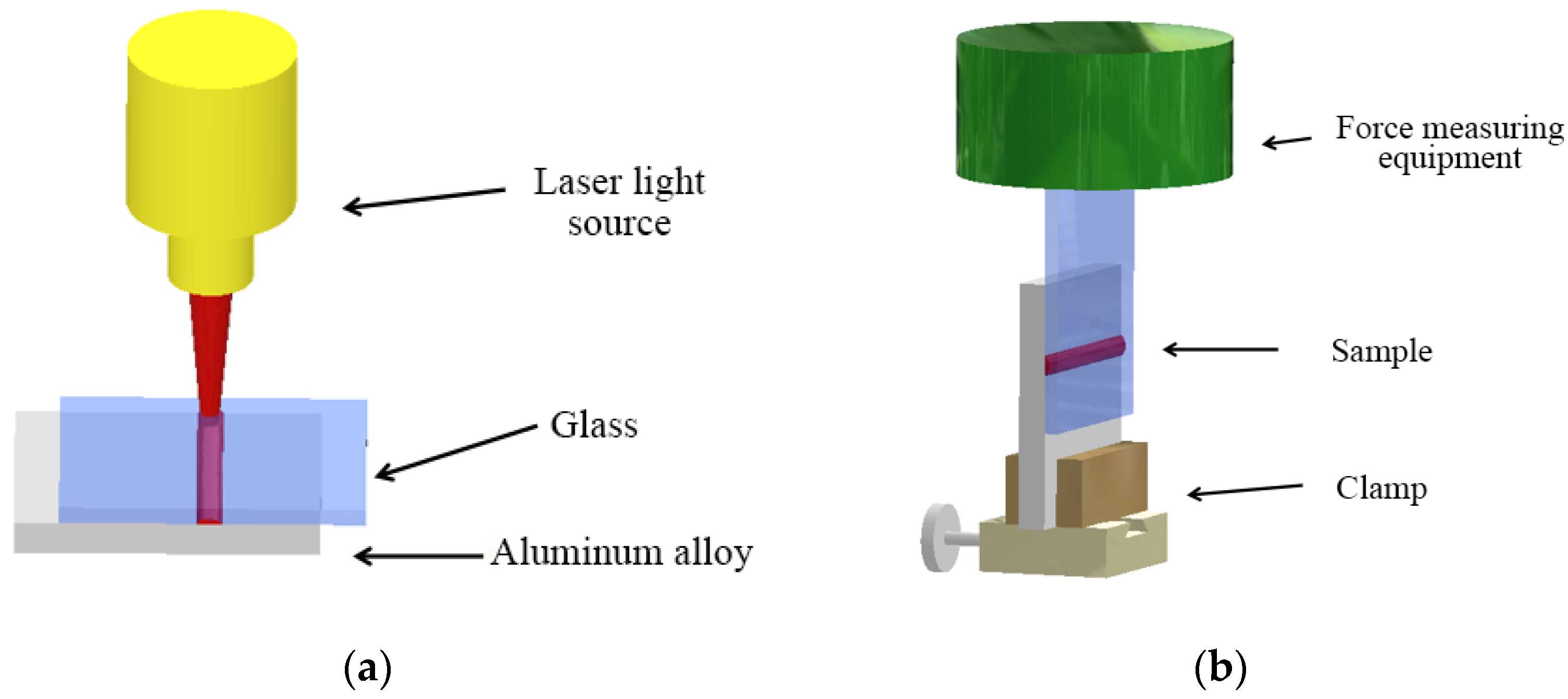


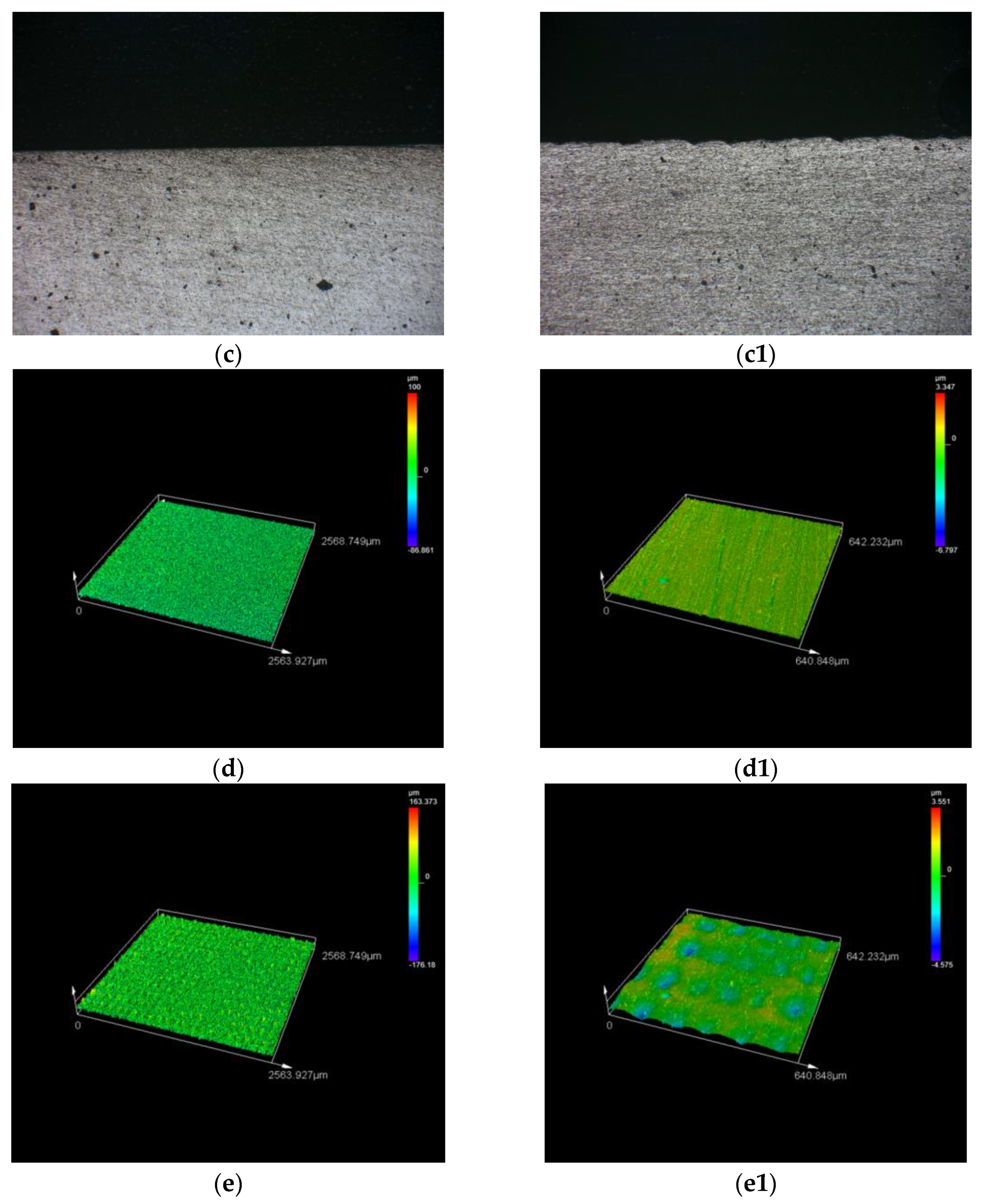


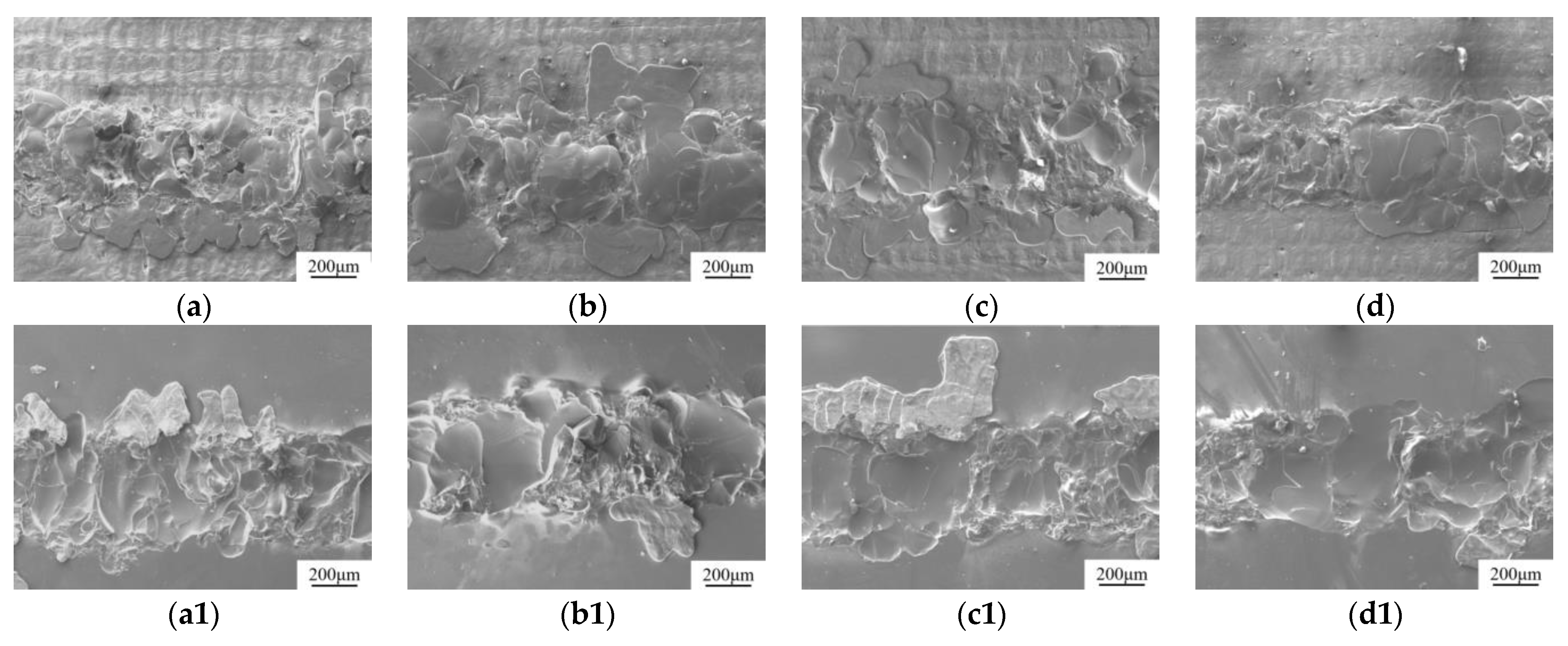


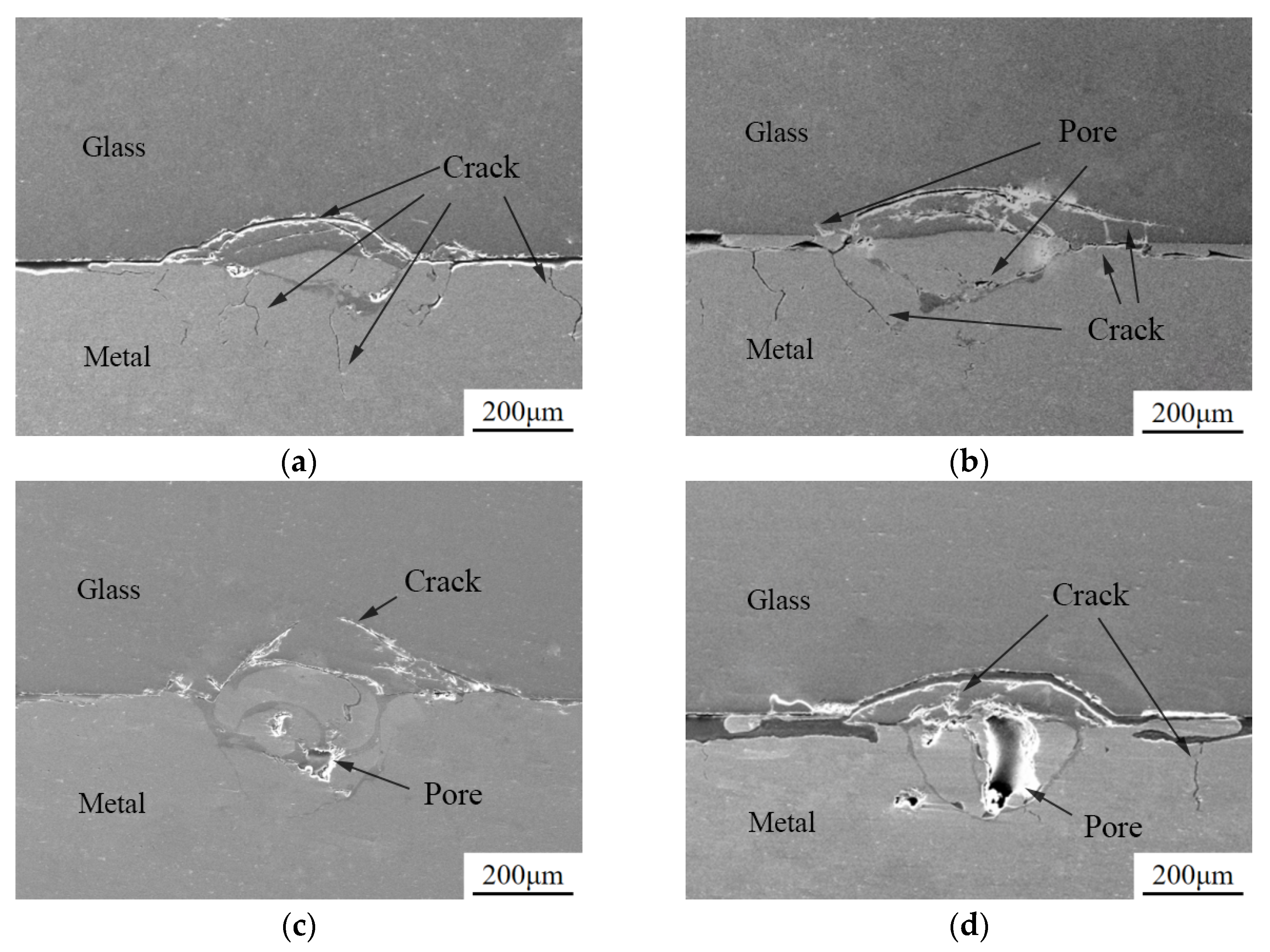
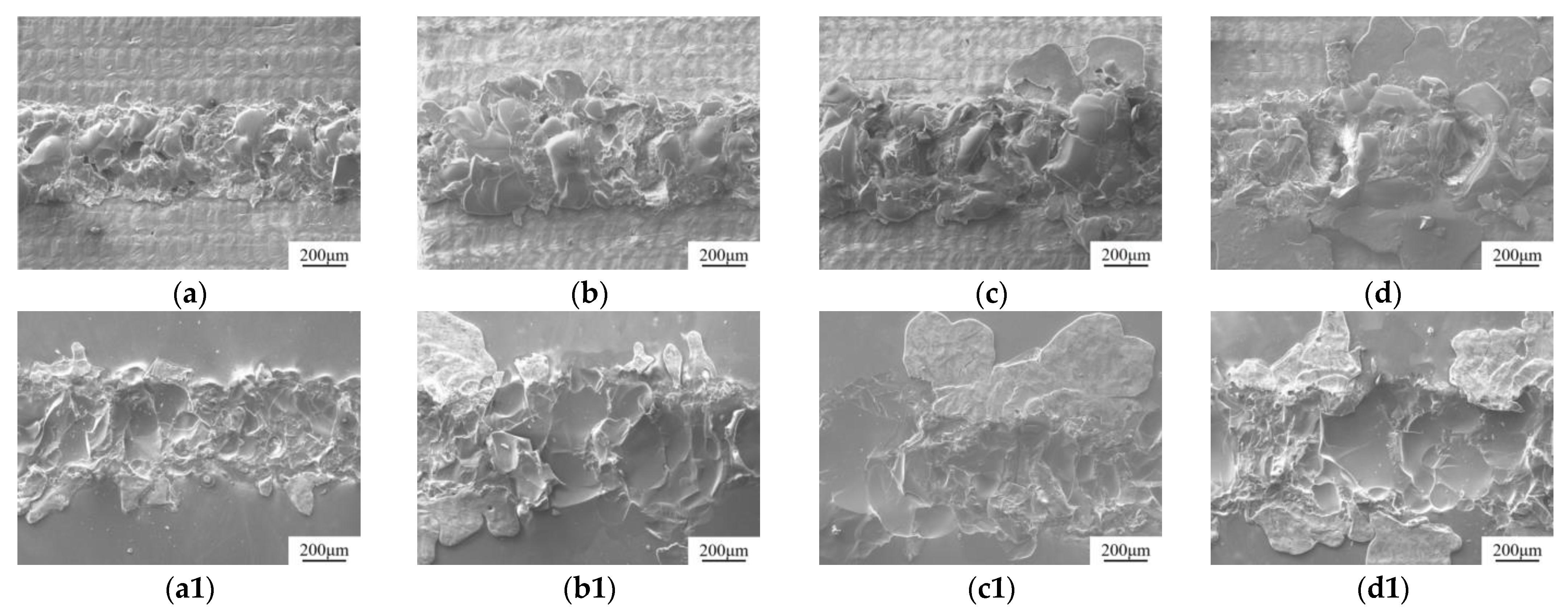

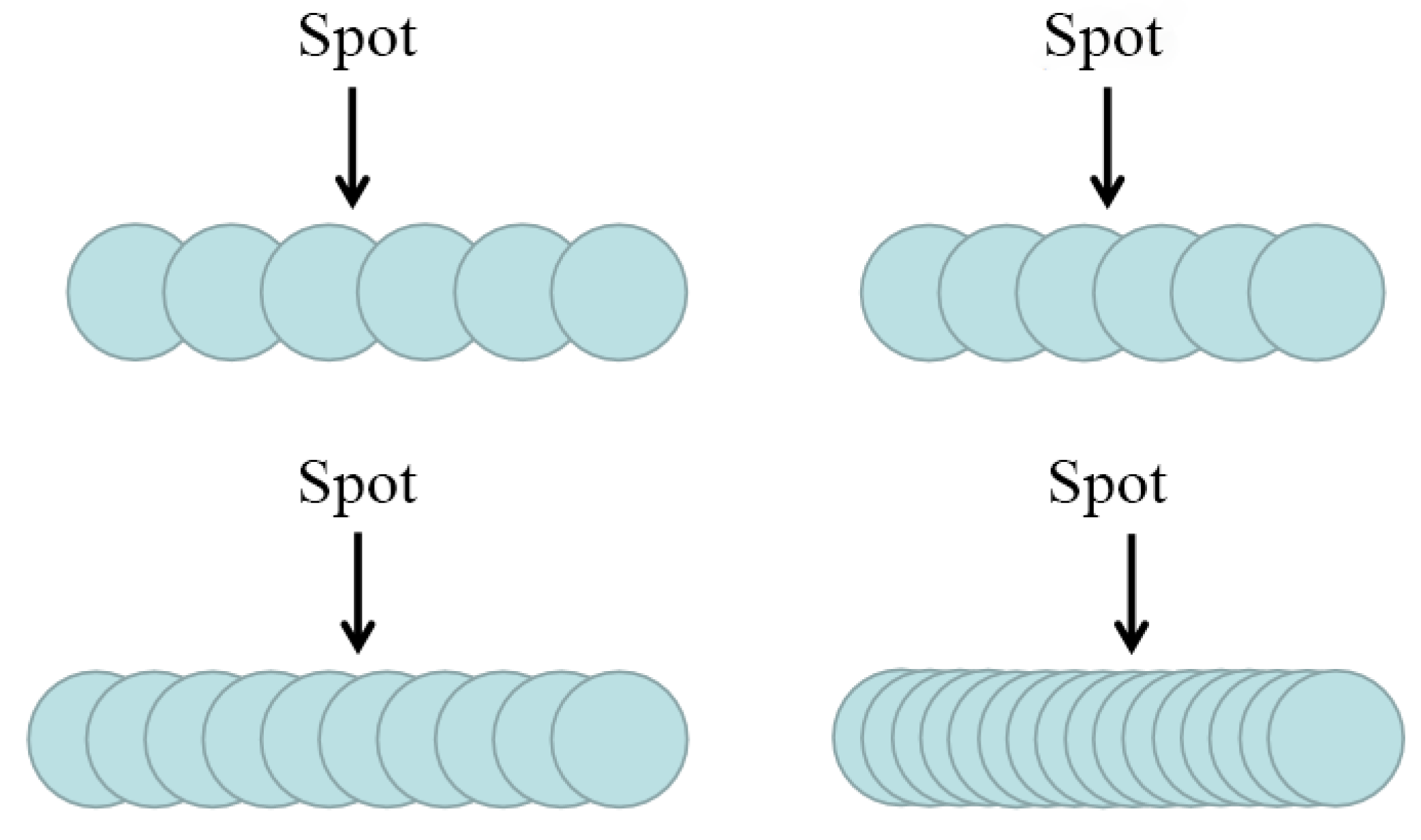

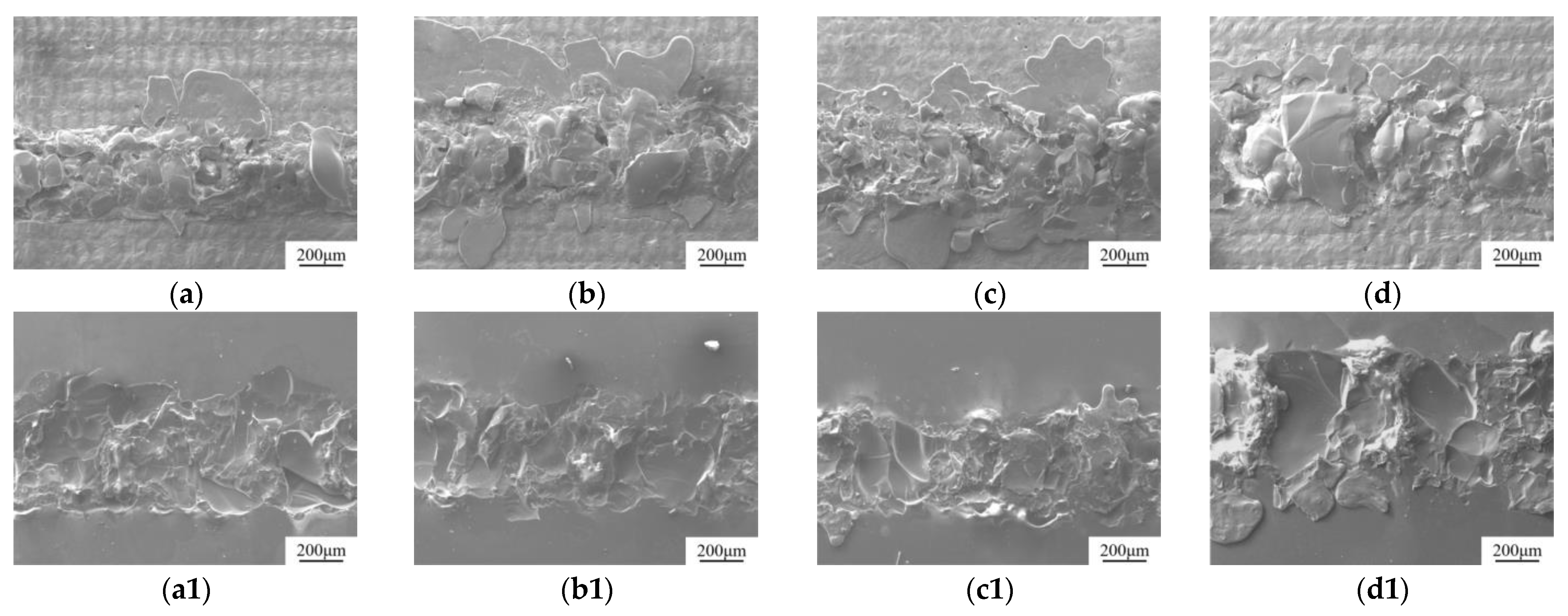


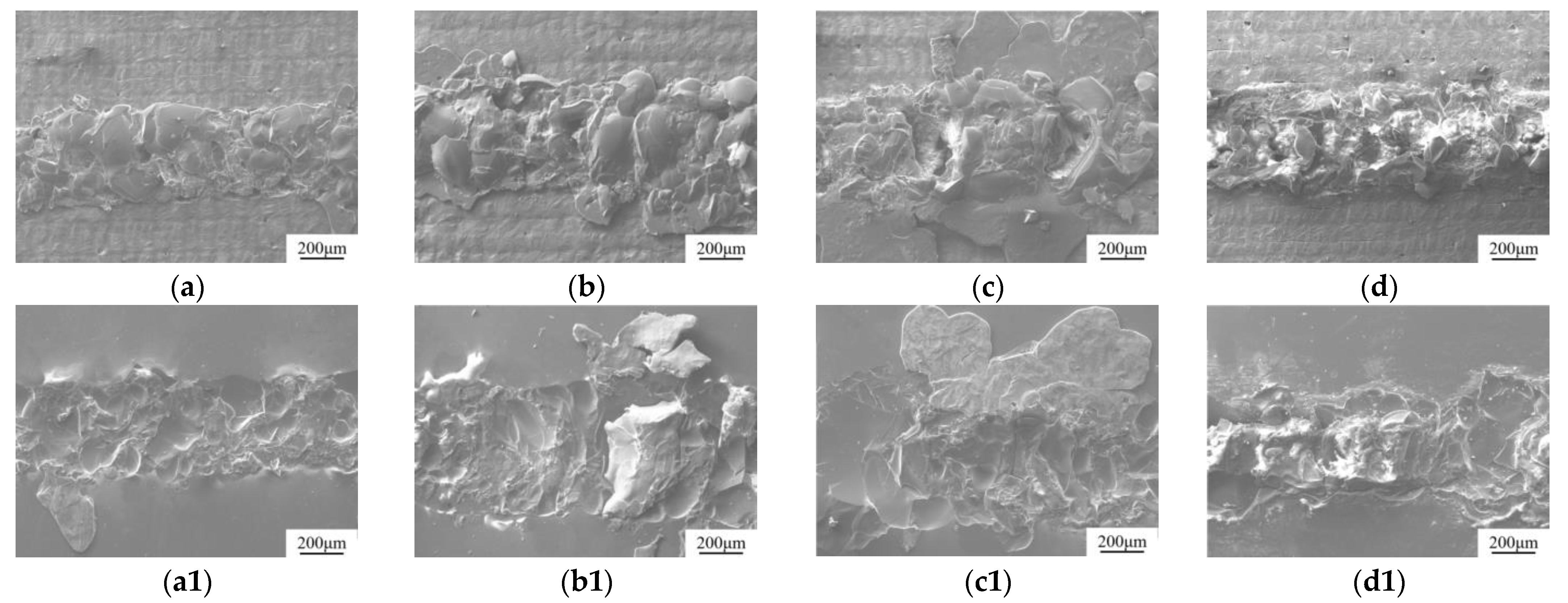
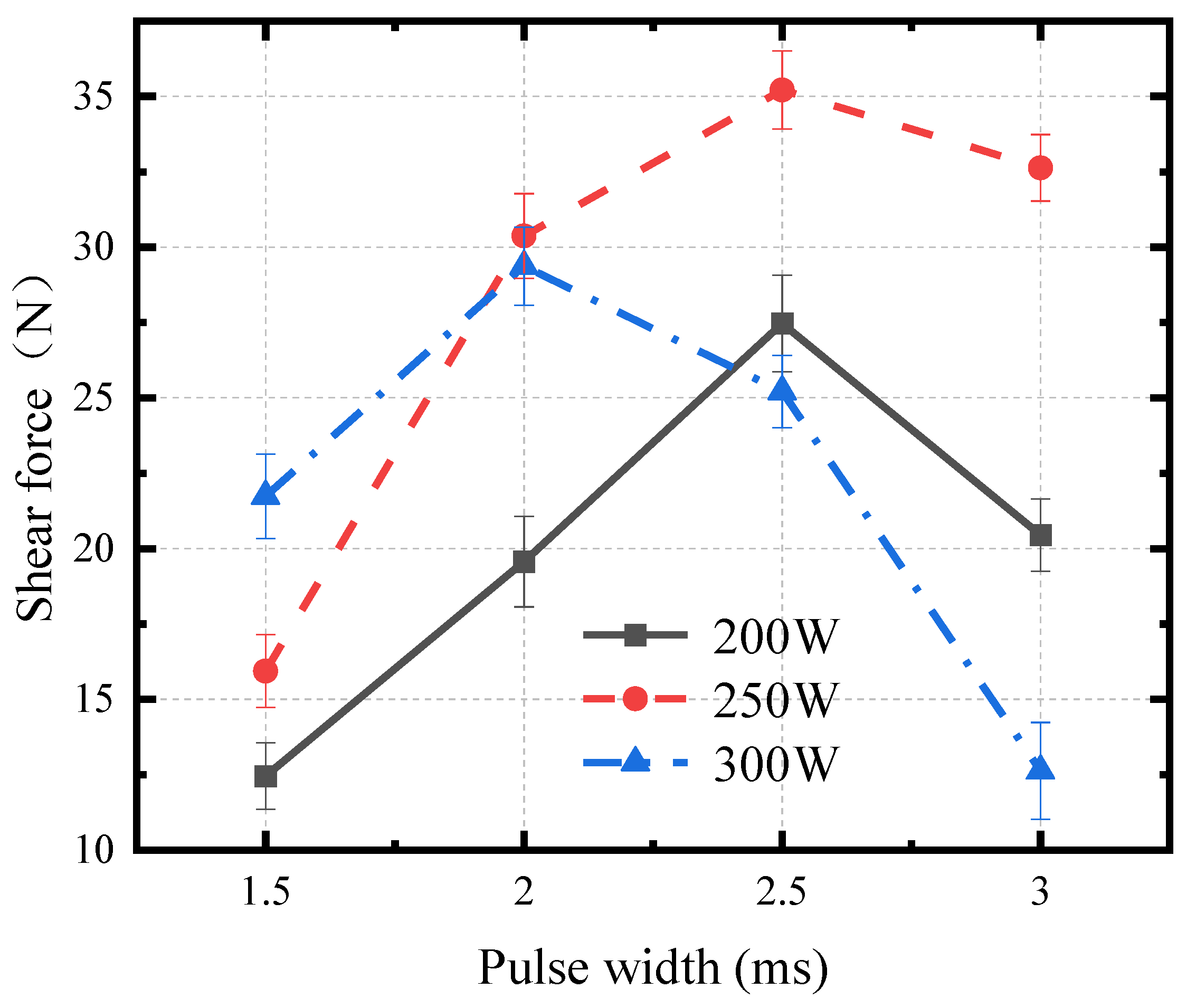
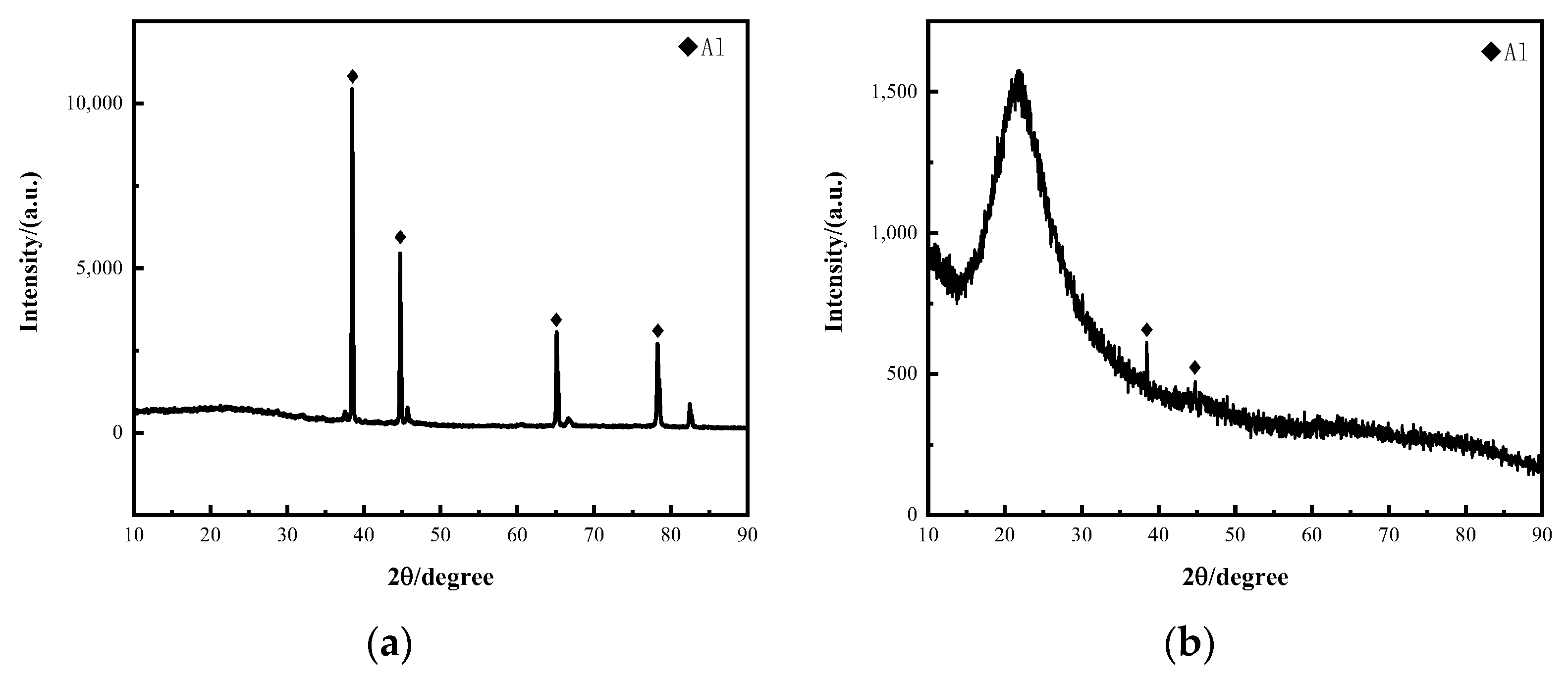
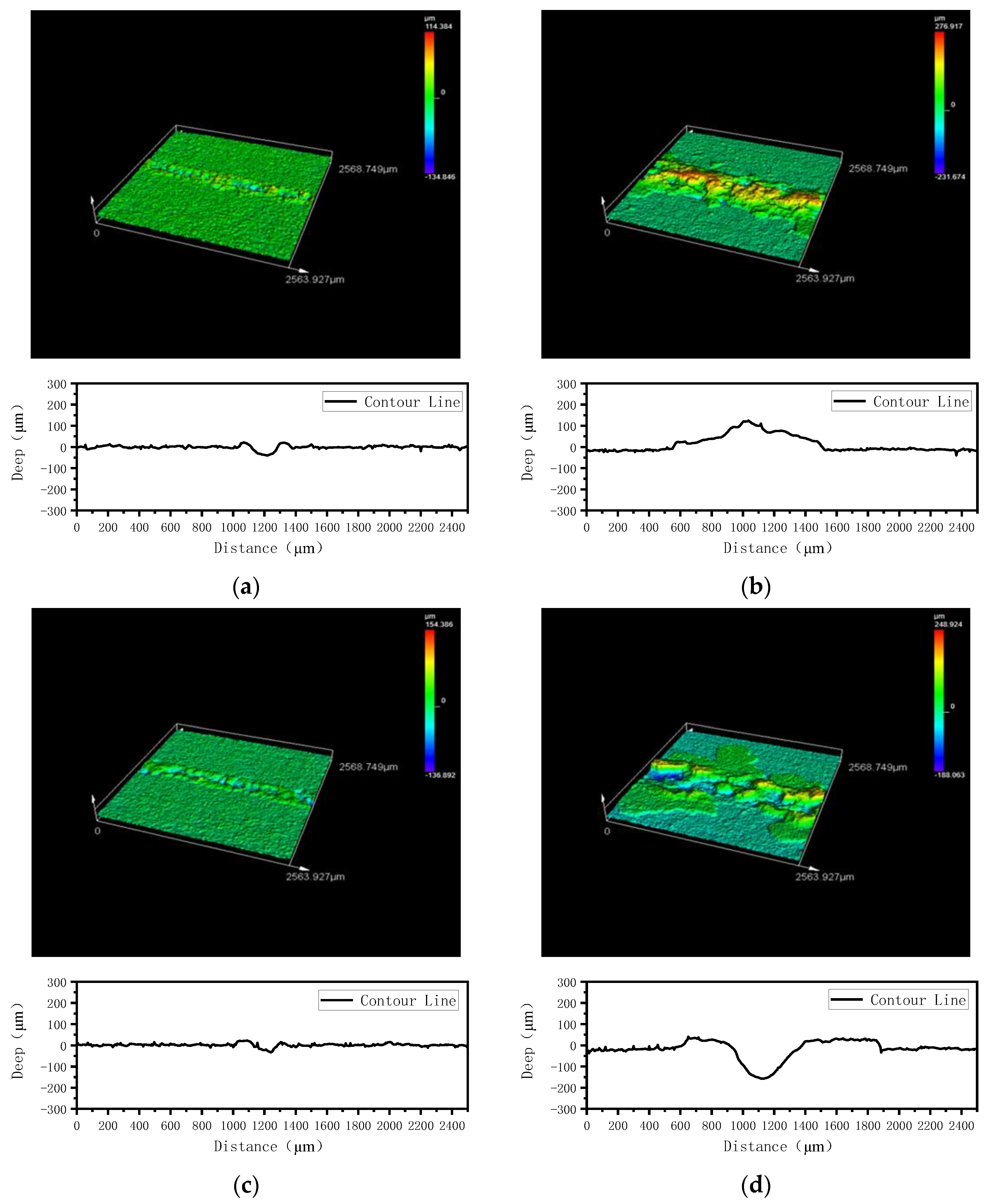
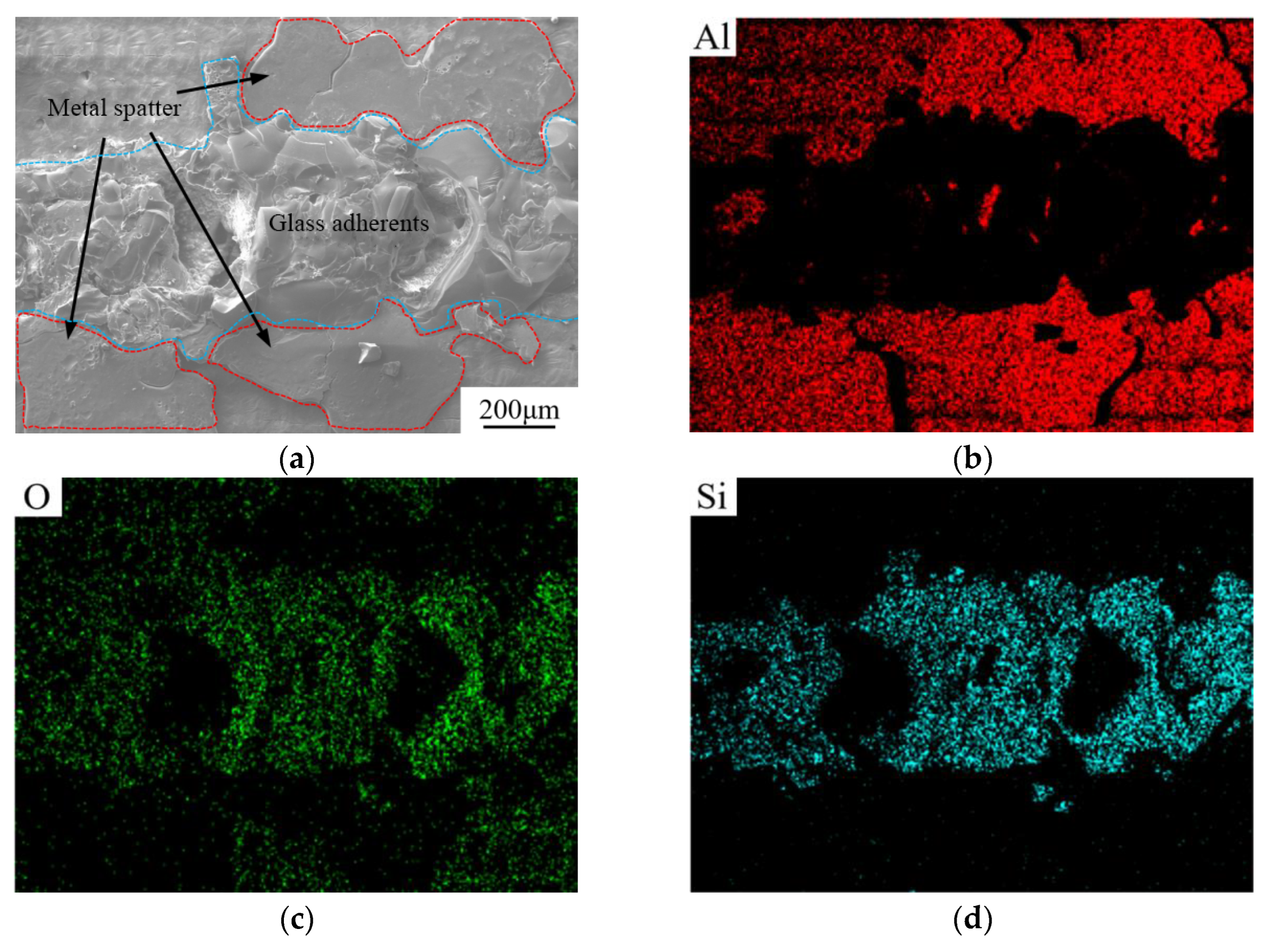
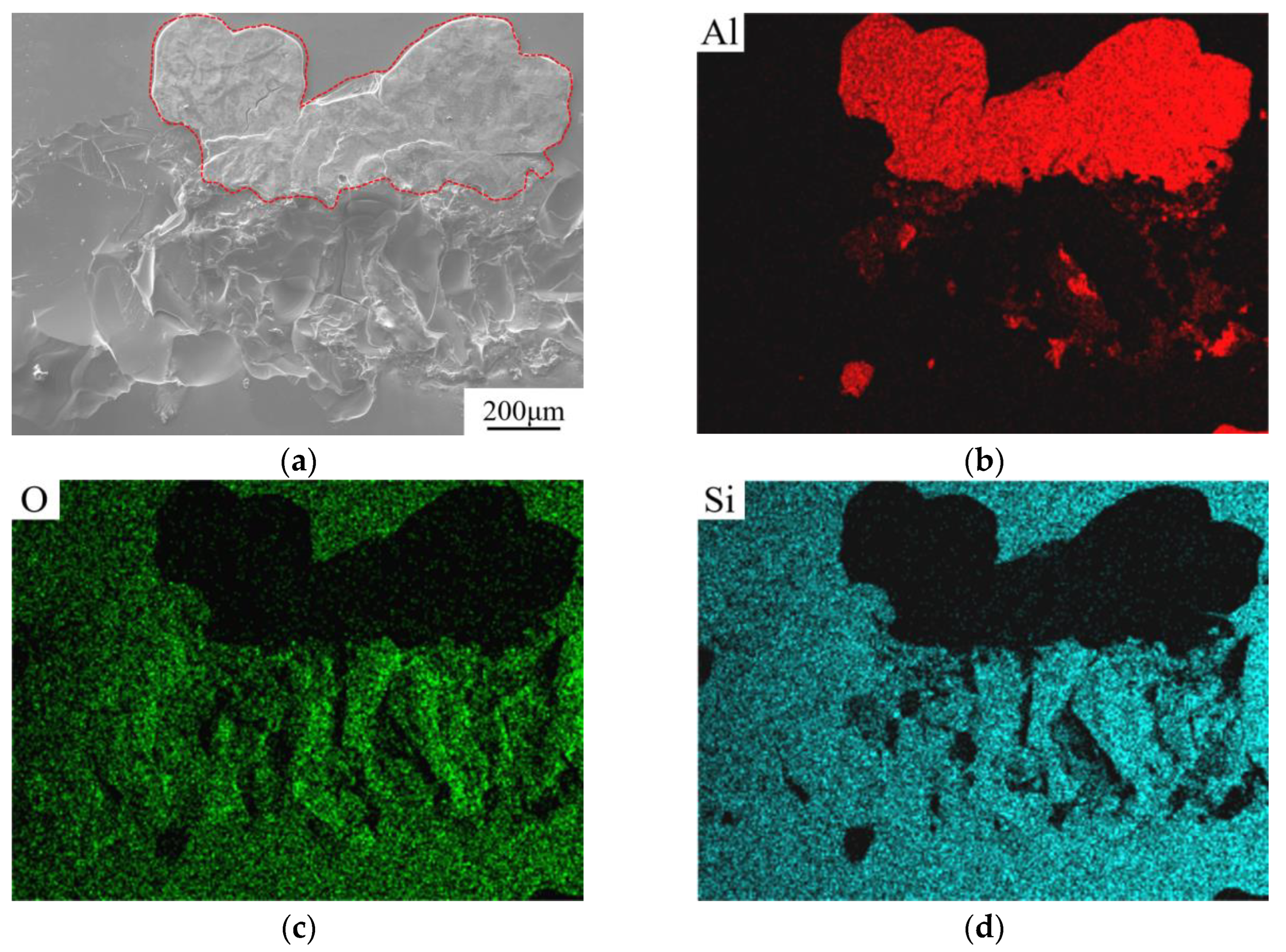
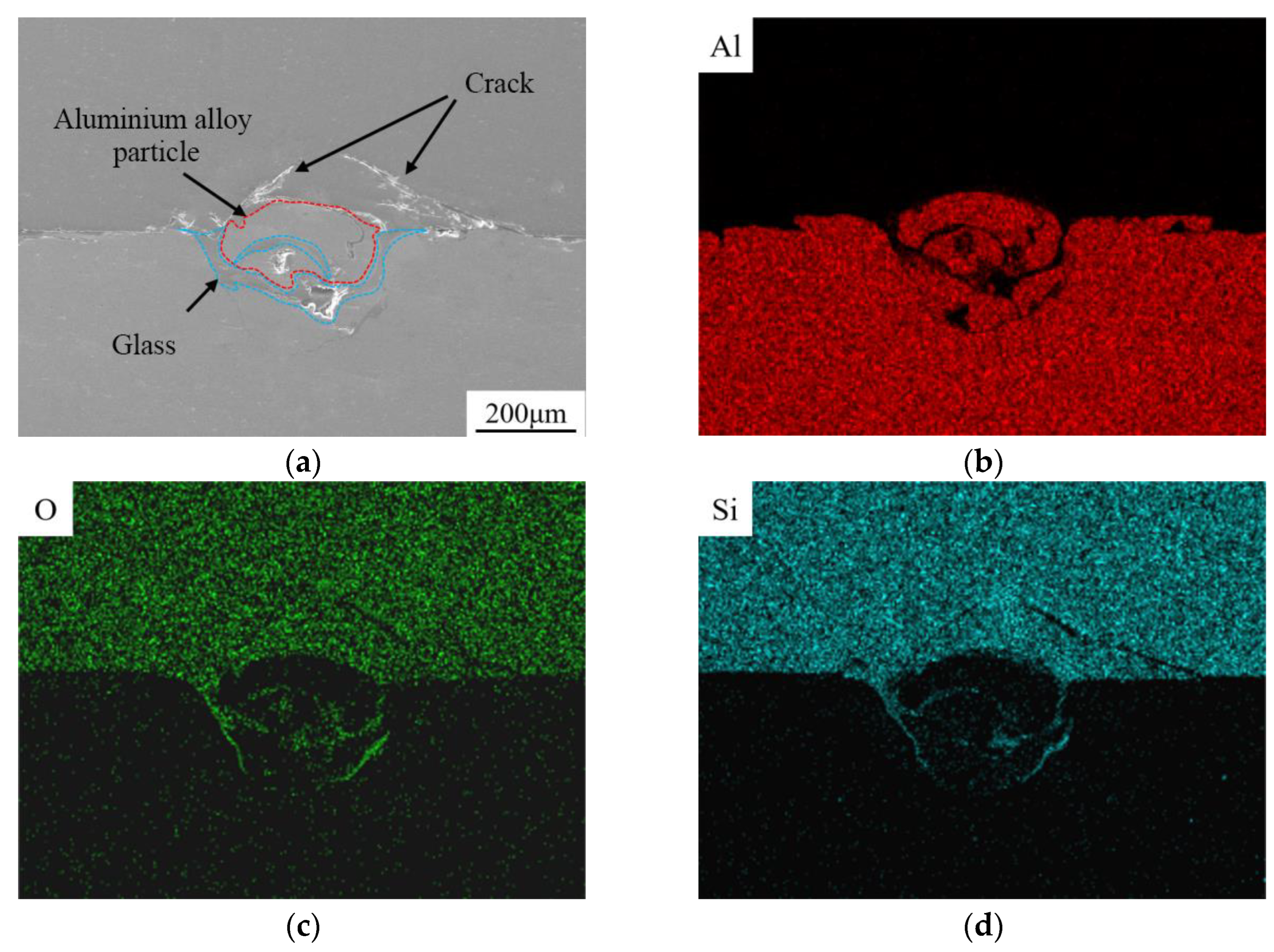


| Al | Si | Cu | Mg | Mn |
|---|---|---|---|---|
| 83.0–85.0 | 11.0–13.0 | 0.2–0.6 | 0.1 | <0.1 |
| SiO2 | Al2O3 | CaO | MgO | Na2O |
|---|---|---|---|---|
| 70–73 | 0–3 | 6–12 | 0–4 | 12–16 |
| Name | Model | Purpose |
|---|---|---|
| CNC Wire Cutting Machine | DK7732 | Cutting metal samples |
| Ultrasonic Cleaning Machine | LTB-500 | Cleaning samples |
| Vacuum Drying Oven | 101-4 | Drying experimental samples |
| Nd: YAG | MD-Focus300 | Welding |
| Electronic Universal Testing Machine | RGM-4100 | Shear strength testing |
| X-ray Photoelectron Spectroscopy (XPS) | EXCALAB 250 XI | Phase analysis |
| Scanning Electron Microscope (SEM) | EVO18 | Morphological observation and spectroscopy |
| Grinding and Polishing Machine | MP-2A | Grinding and polishing samples |
| Confocal Colored Electron Microscope | OLS5000-SAF | Observing three-dimensional morphology |
| Spectrophotometer | 7230G | Testing absorbance |
| Experiment Number | Power | Frequency | Pulse Width | Defocus Amount |
|---|---|---|---|---|
| 1 | 250 W | 10 Hz | 2.5 ms | −1 |
| 2 | 250 W | 10 Hz | 2.5 ms | 0 |
| 3 | 250 W | 10 Hz | 2.5 ms | 1 |
| 4 | 250 W | 10 Hz | 2.5 ms | 2 |
| 5 | 150 W | 10 Hz | 1.5 ms | 0 |
| 6 | 200 W | 10 Hz | 1.5 ms | 0 |
| 7 | 250 W | 10 Hz | 1.5 ms | 0 |
| 8 | 300 W | 10 Hz | 1.5 ms | 0 |
| 9 | 150 W | 10 Hz | 2.0 ms | 0 |
| 10 | 200 W | 10 Hz | 2.0 ms | 0 |
| 11 | 250 W | 10 Hz | 2.0 ms | 0 |
| 12 | 300 W | 10 Hz | 2.0 ms | 0 |
| 13 | 150 W | 10 Hz | 2.5 ms | 0 |
| 14 | 200 W | 10 Hz | 2.5 ms | 0 |
| 15 | 250 W | 10 Hz | 2.5 ms | 0 |
| 16 | 300 W | 10 Hz | 2.5 ms | 0 |
| 17 | 200 W | 8 Hz | 2.5 ms | 0 |
| 18 | 200 W | 10 Hz | 2.5 ms | 0 |
| 19 | 200 W | 12 Hz | 2.5 ms | 0 |
| 20 | 200 W | 14 Hz | 2.5 ms | 0 |
| 21 | 250 W | 8 Hz | 2.5 ms | 0 |
| 22 | 250 W | 10 Hz | 2.5 ms | 0 |
| 23 | 250 W | 12 Hz | 2.5 ms | 0 |
| 24 | 250 W | 14 Hz | 2.5 ms | 0 |
| 21 | 300 W | 8 Hz | 2.5 ms | 0 |
| 22 | 300 W | 10 Hz | 2.5 ms | 0 |
| 23 | 300 W | 12 Hz | 2.5 ms | 0 |
| 24 | 300 W | 14 Hz | 2.5 ms | 0 |
| 25 | 200 W | 10 Hz | 1.5 ms | 0 |
| 26 | 200 W | 10 Hz | 2.0 ms | 0 |
| 27 | 200 W | 10 Hz | 2.5 ms | 0 |
| 28 | 200 W | 10 Hz | 3.0 ms | 0 |
| 29 | 250 W | 10 Hz | 1.5 ms | 0 |
| 30 | 250 W | 10 Hz | 2.0 ms | 0 |
| 31 | 250 W | 10 Hz | 2.5 ms | 0 |
| 32 | 250 W | 10 Hz | 3.0 ms | 0 |
| 33 | 300 W | 10 Hz | 1.5 ms | 0 |
| 34 | 300 W | 10 Hz | 2.0 ms | 0 |
| 35 | 300 W | 10 Hz | 2.5 ms | 0 |
| 36 | 300 W | 10 Hz | 3.0 ms | 0 |
Disclaimer/Publisher’s Note: The statements, opinions and data contained in all publications are solely those of the individual author(s) and contributor(s) and not of MDPI and/or the editor(s). MDPI and/or the editor(s) disclaim responsibility for any injury to people or property resulting from any ideas, methods, instructions or products referred to in the content. |
© 2024 by the authors. Licensee MDPI, Basel, Switzerland. This article is an open access article distributed under the terms and conditions of the Creative Commons Attribution (CC BY) license (https://creativecommons.org/licenses/by/4.0/).
Share and Cite
Chen, C.; Tang, J.; Zhang, M.; Zhang, W. The Impact of Welding Parameters on the Welding Strength of High Borosilicate Glass and Aluminum Alloy. Metals 2024, 14, 1001. https://doi.org/10.3390/met14091001
Chen C, Tang J, Zhang M, Zhang W. The Impact of Welding Parameters on the Welding Strength of High Borosilicate Glass and Aluminum Alloy. Metals. 2024; 14(9):1001. https://doi.org/10.3390/met14091001
Chicago/Turabian StyleChen, Changjun, Jian Tang, Min Zhang, and Wei Zhang. 2024. "The Impact of Welding Parameters on the Welding Strength of High Borosilicate Glass and Aluminum Alloy" Metals 14, no. 9: 1001. https://doi.org/10.3390/met14091001





